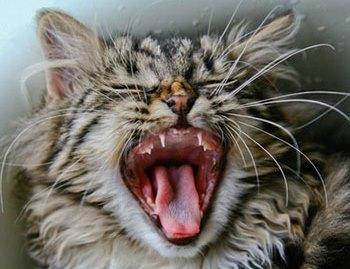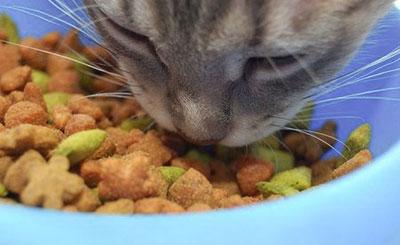This content is archived from the Feline Nutrition Foundation
Bio-Inappropriate: The Dangers of Dry Cat Food
- Updated: Sunday, June 02, 2019 02:20 PM
- Published: Sunday, April 21, 2019 11:12 AM
- Written by Margaret Gates
 "I have never seen a single case of serious obesity, diabetes, urinary tract disease, or IBD in a cat fed meat instead of commercial dry foods. Many other people have seen the same results. Further, I do not see nutritional deficiencies in cats fed properly balanced raw-meat diets. I want to emphasize a point here. The incidence of these problems has not just declined on a raw-meat diet, they have entirely disappeared. These results are too dramatic to ignore."
"I have never seen a single case of serious obesity, diabetes, urinary tract disease, or IBD in a cat fed meat instead of commercial dry foods. Many other people have seen the same results. Further, I do not see nutritional deficiencies in cats fed properly balanced raw-meat diets. I want to emphasize a point here. The incidence of these problems has not just declined on a raw-meat diet, they have entirely disappeared. These results are too dramatic to ignore."
Elizabeth Hodgkins, DVM, from Your Cat: Simple New Secrets to a Longer, Stronger Life.
It is important to remove dry food from your cat's diet. This one change alone is a big step forward in improving cat nutrition and health. Dry food, be it premium, prescription or "natural," harms your cat's health. It consists mostly of starch and carbohydrates – it must be, as it can't be manufactured and extruded otherwise. The quality of the ingredients really doesn't matter – that's not the point. Simply that it is carb-laden and dry is enough to make it a terrible choice for cats. The carbs take the place of healthy meat-derived protein and fats that are vital for an obligate carnivore. All of these factors make dry foods detrimental to health.¹
The problems with dry food are:
- Low moisture content
- High in carbohydrates
- Protein from plant rather than animal sources
Moisture Content
Cats must have water in their food. A mouse is about 65 to 75% moisture.²
Cats evolved getting most of their fluid intake from the foods they ate. They don't drink a lot of water and don't have the thirst drive that dogs or humans have. As creatures that evolved in the desert, they naturally concentrate their urine. A cat getting only dry foods will drink water, but will have a hard time making up for the lack of moisture in the food, leading to even more concentrated urine. This can promote feline lower urinary tract disease.³
Cats should be fed a diet with a moisture content that is close to what their natural prey diet would be: around 65 to 80 percent moisture. A raw cat food or a canned diet both are in this range. For more information on this, see "Answers: What Dry Food Does to Your Cat's Pee."
High in Carbohydrate
 A cat's natural diet, usually rodents, rabbits, insects and birds, is usually less than 2% carbohydrate. Dry cat food is generally 25-50% carbohydrate.⁴ Not only does this excess carbohydrate promote obesity in cats, but it's also implicated in diabetes. Obesity doesn't cause diabetes. Rather, obesity and diabetes appear to have the same cause, too much carbohydrate in the diet.⁵
A cat's natural diet, usually rodents, rabbits, insects and birds, is usually less than 2% carbohydrate. Dry cat food is generally 25-50% carbohydrate.⁴ Not only does this excess carbohydrate promote obesity in cats, but it's also implicated in diabetes. Obesity doesn't cause diabetes. Rather, obesity and diabetes appear to have the same cause, too much carbohydrate in the diet.⁵
From Lisa A. Pierson, DVM: "Cats have a physiological decrease in the ability to utilize carbohydrates due to the lack of specific enzymatic pathways that are present in other mammals, and they lack a salivary enzyme called amylase. Cats have no dietary need for carbohydrates and, more worrisome is the fact that too many carbohydrates can be highly detrimental to their health."⁶
From Kymythy R. Schultze, CN, CNC: "Another good reason not to feed grain is the fact that it breaks down into sugar within the body – something a cat definitely doesn't need! Many studies link sugar consumption to illness, including cancer. Eating a high-carb diet really wreaks havoc on a cat's body. Carbs are usually thought of as energy foods, but felines utilize protein and fat very efficiently for those needs."⁷
Protein From Plant Sources
 From Lyn Thomson, BVSc: "In commercial cat food, a product's stated protein percentage can ignore two very important factors:
From Lyn Thomson, BVSc: "In commercial cat food, a product's stated protein percentage can ignore two very important factors:
- How packed full of essential amino acids is that particular protein source?
- What is the biological value of that protein to the cat?
The biological value of the protein tells us how beneficial that protein is to our cats – how readily that protein can be utilised by the cat. In other words, the higher the biological value, the more usable it is to the cat.
Chicken eggs are used as a benchmark by which all other proteins are judged. They have a biological value of 100 – due to their near perfect usability. The biological value of chicken is 79, beef is 80. The biological value of wheat is 60, and of corn is 54.⁸ It is easy to conclude that meat proteins will have a higher digestibility for cats than plant proteins."
From Kymythy R. Schultze, CN, CNC: "Complete proteins contain ample amounts of essential amino acids and are found in foods such as meat, fish, eggs, and poultry. Incomplete proteins do not provide all essential amino acids and are found in many foods, including legumes, grains, and vegetables. These plant proteins don't provide the essential amino acids that a cat needs, such as taurine, which come from animal protein."⁹
A Few Other Reasons to Avoid Dry Cat Food
Dry foods are not good for your cat's dental health. People like to think that dry foods help clean a cat's teeth, but the opposite is true. According to Dr. Guillermo Díaz, MV: "The shape of the kibble is generally small in size which makes it very difficult for a cat to chew on, so they generally swallow the whole pellet as presented. This has zero polishing effect on the surface of the teeth. Moreover, when in contact with the saliva, the high content of carbohydrates, or polysaccharides, in the pellet is released and adheres on the surface of the teeth causing the first stage in the formation of tartar and periodontal disease: the formation of dental plaque."¹⁰ For much more on this, check out "Answers: What Dry Food Does to Your Cat's Teeth."
Dry food as it is initially manufactured would be of no interest to a cat. It must be sprayed with flavorings and their accompanying odors to interest the cat in eating it.¹¹ An entire industry has arisen to manufacture such sprays for this biologically-inappropriate food product.
Dry food can be contaminated with mold, fungus or mycotoxins due to improper grain storage.¹² As kibble is unlikely to be made from the highest quality grain – perhaps grain not fit for human consumption – it is a further concern. Dry food should never be moistened with water, as it creates an ideal soup in which mycotoxins can proliferate. Read "Answers: One More Reason to Ditch Dry Food."
Additional Reading
Just What is a Raw Cat Food Diet, Anyway?
Beginner's Luck: Where Do I Start?
Pet food recalls involving salmonella contamination are commonly for dry pet food.¹³ Dry food can be more dangerous than raw cat food because people are not cautious about handling it. With raw food for cats, safe handling and feeding practices are followed, so contamination is unlikely.
Margaret Gates is the founder of the Feline Nutrition Foundation.
1. J. S. Rand, L. M. Fleeman, H. A. Farrow, D. J. Appleton, and R. Lederer, "Canine and Feline Diabetes Mellitus: Nature or Nurture?," The Journal of Nutrition, August 2004.
Peter J. Markwell, C. Tony Buffington, and Brigitte H. E. Smith, "The Effect of Diet on Lower Urinary Tract Diseases in Cats," The Journal of Nutrition 128, no. 12, December 1998, 2753S-2757S.
2. Ellen S. Dierenfeld, PhD, Heather L. Alcorn, BS, and Krista L. Jacobsen, MS, "Nutrient Composition of Whole Vertebrate Prey (Excluding Fish) Fed in Zoos," 2002.
3. Peter J. Markwell, C. Tony Buffington, and Brigitte H. E. Smith, "The Effect of Diet on Lower Urinary Tract Diseases in Cats," The Journal of Nutrition 128, no. 12, December 1998, 2753S-2757S
4. Michael S. Hand, DVM, PhD; Craig D. Thatcher, DVM, MS, PhD, Rebecca L. Remillard, PhD, DVM, and Philip Roudebush, DVM, Small Animal Clinical Nutrition,4th ed. Walsworth Publishing Company, 2000, 1075, 1077.
5. J. S. Rand, L. M. Fleeman, H. A. Farrow, D. J. Appleton, and R. Lederer, "Canine and Feline Diabetes Mellitus: Nature or Nurture?," The Journal of Nutrition, August 2004.
Susan Donoghue and Janet M. Scarlett, "Diet and Feline Obesity," The Journal of Nutrition 128, no. 12, December 1998, 2776S-2778S.
6. Lisa A. Pierson, DVM, "We Are Feeding Cats Too Many Carbohydrates."
7. Kymythy R. Schultze, CN, CNC, Natural Nutrition for Cats, Hay House, Inc., 2008, 29.
8. JG Morris, "Idiosyncratic Nutrient Requirements of Cats Appear to be Diet-induced Evolutionary Adaptations," Nutrition Research Reviews 15, no. 1, June 2002, 153-68.
9. Kymythy R. Schultze, CN, CNC, Natural Nutrition for Cats, Hay House, Inc., 2008, 23.
10. C Zambori, E Tirziu, I Nichita, C Cumpanasoiu, RV Gros, M Seres, B Mladin and D Mot, "Biofilm Implication in Oral Diseases of Dogs and Cats," Scientific Papers: Animal Science and Biotechnologies 45, no. 2, 2012.
11. Christopher S. Cowell, Neil P. Stout, Mark F. Brinkman, Edward A. Moser, and Stephen W. Crane, "History of Pet Food Manufacture in the United States," Small Animal Clinical Nutrition,4th ed. Walsworth Publishing Company, 2000, 132-134.
12. Maxwell C. K. Leung, Gabriel Díaz-Llano, and Trevor K. Smith, "Mycotoxins in Pet Food: A Review on Worldwide Prevalence and Preventative Strategies," Journal of Agricultural and Food Chemistry 54, 2006, 9623-9635.
13. "Update: Recall of Dry Dog and Cat Food Products Associated with Human Salmonella Schwarzengrund Infections – United States, 2008," Morbidity and Mortality Weekly Report, Centers for Disease Control, November 7, 2008.




